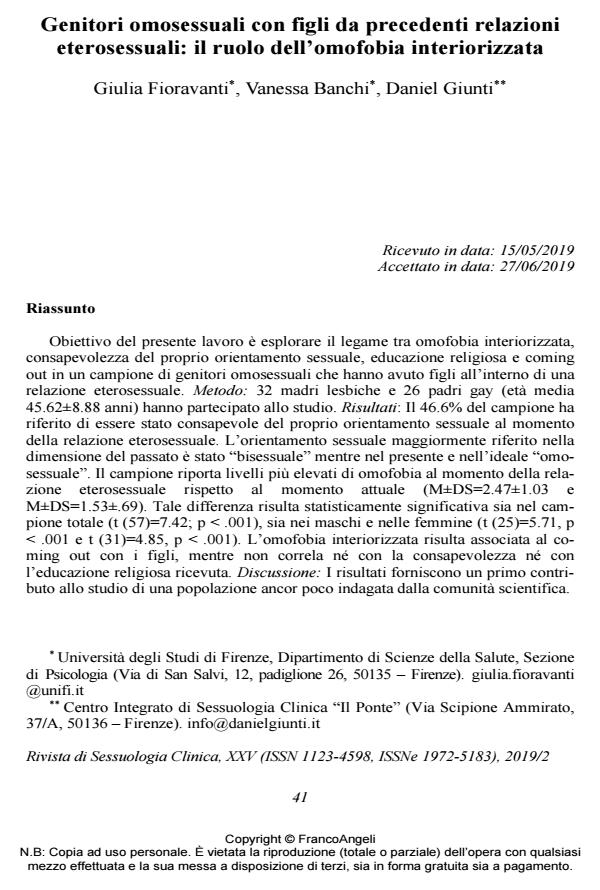Homosexual parents with children from previous heterosexual relationships: the role of internalized homophobia
Journal title RIVISTA DI SESSUOLOGIA CLINICA
Author/s Giulia Fioravanti, Vanessa Banchi, Daniel Giunti
Publishing Year 2019 Issue 2019/2
Language Italian Pages 21 P. 41-61 File size 253 KB
DOI 10.3280/RSC2019-002003
DOI is like a bar code for intellectual property: to have more infomation
click here
Below, you can see the article first page
If you want to buy this article in PDF format, you can do it, following the instructions to buy download credits

FrancoAngeli is member of Publishers International Linking Association, Inc (PILA), a not-for-profit association which run the CrossRef service enabling links to and from online scholarly content.
In Italy, homosexual people are not allowed to adopt a child or to perform do-nor insemination/surrogacy, thus they become parents mainly in the context of previous heterosexual relationships (Barbagli, Colombo, 2007). Data from the Ital-ian Superior Sanity Institute on 7000 homosexual individuals (2006) revealed that 18% of gay men and 21% of lesbians were parents. Despite their growing diffu-sion, mixed-oriented marriages (i.e. same sex attracted people who are ‒ or were-married with opposite sex partners) are still scarcely investigated by the scientific community. Previous international studies (Higgins, 2004; 2006) have tried to identify possible explanations for the phenomenon, evidencing an important role for internalized homophobia ‒ the homosexual individual’s negative feelings and attitudes toward homosexuality-. However, this topic has not been previously in-vestigated in Italy. The aim of the present study is to explore the association be-tween internalized homophobia, awareness of sexual orientation, religious educa-tion and coming out in a sample of Italian homosexual parents with children from previous heterosexual relationships. Method: Participants were recruited through the e-mail lists of Rete Genitori Rainbow and Famiglie Arcobaleno, two voluntary associations of Italian homosexual and bisexual parents. 32 lesbian mothers and 26 gay fathers (mean age 45.62 ± 8.88 years) participated in the study. Infor-mation about past and current relationship status, awareness of sexual orientation at the time of marriage, coming out and religious education were collected. Sexual orientation was measured both through the Kinsey Scale (Kinsey Pomeroy e Mar-tin, 1948) and the Modified Klein Sexual Orientation Grid (MKSOG) (Moore, 2000). MKSOG assesses seven domains of human sexuality (i.e. sexual attraction, behavior, and fantasies, emotional and social preference, lifestyle as well as self-identification) at three different points of measurement (past, present, and ideal), thus offering a more expanded definition of sexual orientation than the one-dimensional Kinsey Scale. Internalized homophobia at the time of marriage and at the present time was assessed through the Measure of Internalized Sexual Stig-ma for Lesbian and Gay Men (MISS-LG) (Lingiardi, Baiocco e Nardelli, 2012). Results: Most of the sample (79.3%) has been married with the opposite sex part-ner (marriage mean duration: 14.16 ± 6.98 years). 13.8% of the participants is still in a heterosexual relationship, while 69% has currently a same sex partner (rela-tionship mean duration: 4.62±4.48 years). 46.6% of the participants were aware of their homosexual orientation when they entered into the heterosexual relationship in which they become parents. Sexual orientation has been found to change from the past time to the present time, both in men and in women. While half of the sample reported a “bisexual” sexual orientation in the past, most of the sample (75.90%) described themselves as "homosexual" at the present time. Noteworthy, 32.80% of the participants defined themselves as "heterosexual" at the time of marriage. Gender differences were found in internalized homophobia levels with men reported higher scores than women, both at the time of marriage and at the present time. Participants reported higher levels of internalized homophobia at the time of the heterosexual relationship compared to the present time (M±SD=2.47±1.03 and M±SD=1.53±.69). This difference was statistically signifi-cant both in the total sample (t (57)=7.42; p < .001), and in males and females (t (25)=5.71, p < .001; t (31)=4.85, p < .001). Internalized homophobia is associated with coming out with children, while it did not correlate with awareness of sexual orientation and religious education. Parents who have not declared their sexual orientation to their children reported higher levels of internalized homophobia rela-tive to parents who came out with their children (M±SD=2.16±1.07, M±SD=1.32±.33 respectively, t (56)=‒ 4.58 p < .001). Discussion: The current re-sults provide a first contribution to the study of a specific population, still scarcely investigated by the scientific community. In line with previous studies (Higgins, 2004; 2006) internalized homophobia decreased from the time of marriage to the present time, suggesting its possible role in the phenomenon of mixed-oriented marriages. Moreover, internalized homophobia resulted to be an obstacle for the coming out process with children. Present findings can help health care profession-als and therapists to become aware of the influence that internalized homophobia has on gay and lesbian parents’ lives. The investigation of this aspect can help in-dividuals to achieve greater self-acceptance and, consequently, better psychologi-cal well-being.
Keywords: Homosexuality, gay fathers, lesbian mothers, sexual orientation, com-ing out, internalized homophobia.
Giulia Fioravanti, Vanessa Banchi, Daniel Giunti, Genitori omosessuali con figli da precedenti relazioni eterosessuali: il ruolo dell’omofobia interiorizzata in "RIVISTA DI SESSUOLOGIA CLINICA" 2/2019, pp 41-61, DOI: 10.3280/RSC2019-002003